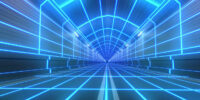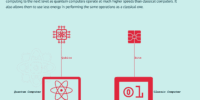What Is Quantum Error Correction and Its Implications
Are you curious about quantum error correction and its implications? Well, you’re in luck!
In this article, we’ll delve into the basics of quantum error correction, explore the types of errors in quantum computing, and discuss the principles and techniques used to correct them.
We’ll also highlight the latest applications and advancements in this field and examine how quantum error correction is set to revolutionize future technologies.
So, sit back, relax, and let’s dive into the intriguing world of quantum error correction!
Key Takeaways
- Quantum error correction techniques are essential for safeguarding quantum data and ensuring accuracy and reliability in quantum computations.
- Different types of errors, such as decoherence, gate errors, and readout errors, can be detected and corrected using error correction codes.
- Measurement-based error correction and fault-tolerant quantum computing are some of the principles and techniques used in quantum error correction.
- Advancements in quantum error correction have the potential to revolutionize various fields, including computing, communication, and cryptography, and pave the way for real-world implementation of quantum computing.
The Basics of Quantum Error Correction
Now let’s dive into the basics of quantum error correction and how it can help you protect your quantum information.
Quantum error correction techniques are essential to safeguard your valuable quantum data from errors that can occur during quantum computations. These techniques involve the use of error detection methods that can identify and correct errors in quantum states.
By employing error correction techniques, you can ensure the accuracy and reliability of your quantum information, which is crucial in the field of quantum computing.
Error detection methods, such as the use of stabilizer codes and error syndromes, play a vital role in identifying errors and providing the necessary information to correct them.
Quantum error correction is a fundamental aspect of quantum computing, allowing you to preserve the integrity of your quantum information and pave the way for future advancements in this exciting field.
Types of Errors in Quantum Computing
First, let’s talk about the different types of errors you might encounter in quantum computing. Quantum systems are extremely sensitive and prone to errors due to various factors. Here are three common error sources in quantum computing:
-
Decoherence: This occurs when the quantum state of a qubit becomes entangled with its surrounding environment, causing loss of information and disruption in computations.
-
Gate Errors: Imperfections in quantum gates can lead to incorrect operations and affect the accuracy of quantum algorithms.
-
Readout Errors: When measuring the state of a qubit, there can be errors in the detection process, resulting in inaccurate results.
To mitigate these errors, several strategies are employed in quantum systems:
-
Quantum Error Correction Codes: These codes use redundancy to detect and correct errors, ensuring the accuracy of computations.
-
Error Detection and Correction Protocols: Techniques such as error detection, error correction, and fault tolerance are implemented to minimize errors and maintain the integrity of quantum information.
-
Quantum Error Mitigation: This involves techniques like error mitigation through error amplification, error suppression, and error extrapolation to minimize the impact of errors on quantum computations.
Principles and Techniques of Quantum Error Correction
To improve the reliability and stability of quantum computing systems, one can implement principles and techniques that focus on detecting and mitigating errors.
One such technique is measurement-based error correction. This involves making measurements on the quantum states to identify and correct errors. This method utilizes the entanglement of qubits to spread the error information across multiple qubits, making it easier to detect and correct errors.
Another important principle is fault-tolerant quantum computing. This aims to design quantum systems that can still perform accurately even in the presence of errors. This involves implementing error-correcting codes, such as the surface code, which can protect against errors and improve the resilience of the quantum system.
Applications and Advancements in Quantum Error Correction
One of the key advancements in this field is the development of fault-tolerant quantum computing systems. These systems are designed to overcome the inherent fragility of quantum bits or qubits, which are the building blocks of quantum computers. With fault-tolerant systems, errors that occur during computation can be detected and corrected, allowing for more reliable and accurate calculations.
Advancements in quantum error correction have paved the way for real-world implementation of quantum computing. Here are three key areas where these advancements have made a significant impact:
-
Enhanced computational power: Fault-tolerant quantum computing systems have the potential to solve complex problems that are currently intractable for classical computers. This opens up new possibilities in areas such as cryptography, optimization, and drug discovery.
-
Improved reliability: By minimizing errors in quantum computations, fault-tolerant systems enable more reliable and consistent results. This is crucial for applications that require high precision and accuracy.
-
Scalability: The development of fault-tolerant systems has brought us closer to building large-scale quantum computers. These systems can handle a greater number of qubits and perform more complex calculations, bringing us closer to achieving practical quantum computing capabilities.
Overall, advancements in fault-tolerant quantum computing systems have brought us closer to realizing the potential of quantum computers in the real world.
Impact of Quantum Error Correction on Future Technologies
As you explore the impact of quantum error correction on future technologies, you’ll discover the immense potential for advancements and breakthroughs in various fields. Quantum error correction has the capability to revolutionize industries such as computing, communication, and cryptography. However, along with its promises come potential challenges that need to be addressed. The table below illustrates some of the potential challenges and future developments in quantum error correction.
| Potential Challenges | Future Developments |
|---|---|
| Fragility of qubits | Development of more robust qubits |
| High error rates | Improvement of error correction codes |
| Scalability issues | Development of scalable and fault-tolerant quantum systems |
Efforts are being made to overcome these challenges and pave the way for the integration of quantum error correction into future technologies. With continued research and development, quantum error correction has the potential to unlock unprecedented capabilities and drive advancements in various fields.
Frequently Asked Questions
How Does Quantum Error Correction Work at the Physical Level?
Quantum error correction works at the physical level by using error detection codes to protect quantum information from noise and errors. These codes can detect and correct errors, ensuring the accuracy and reliability of quantum computations.
Can Quantum Error Correction Be Applied to Classical Computing Systems?
Quantum error correction can be applied to classical computing systems. It offers benefits such as increased data reliability and fault tolerance, making it applicable to improve the performance and stability of classical computers.
What Are the Limitations and Challenges of Implementing Quantum Error Correction in Practice?
Implementing quantum error correction in practice presents limitations and challenges. The complexity of building error-correcting codes, the susceptibility to noise and decoherence, and the need for high-quality qubits are among the main obstacles to overcome.
Are There Any Potential Risks or Drawbacks Associated With Quantum Error Correction?
There are potential risks and drawbacks associated with quantum error correction. Ethical considerations arise due to the potential impact on security. It is important to carefully evaluate and address these concerns.
How Does Quantum Error Correction Impact the Overall Performance and Efficiency of Quantum Computing Systems?
Quantum error correction greatly impacts the overall performance and efficiency of quantum computing systems. It improves computational accuracy but comes with trade-offs such as reduced computational speed.








